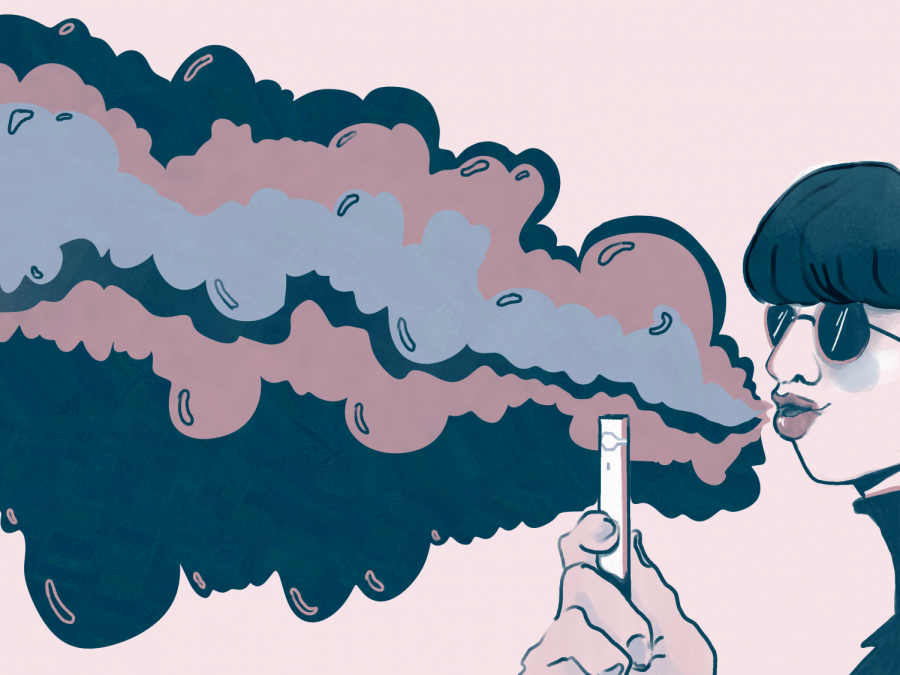Vaping: What is Going On?
Examining the recent events in vaping and how students have been affected.
October 1, 2019
According to CASAA, the first electronic cigarette device was created in the 1960s, but it was not until between 2006 and 2007 that the first e-cigarette was introduced to the United States. Since then, Yale Medicine has reported that 3.6 million middle and high school students use e-cigarettes.
As the popularity of this drug increases, mysterious new problems have arisen.
According to Yale Medicine, “during a recent media briefing, the CDC advised people to avoid e-cigarettes while federal and state officials investigate a nationwide outbreak of severe respiratory illnesses associated with the use of e-cigarette, or vaping, products.”
According to the CDC, there are now 530 probable cases of the vaping illness, but there have also been deaths.
“A California man has become the seventh person to die from a vaping-related illness in the United States,” said CNN. “[He is the second to die in California], plus one person each in Kansas, Illinois, Indiana, Minnesota and Oregon.”
The symptoms of this illness include a cough, shortness of breath, chest pain, nausea, and vomiting, according to the CDC.
Along with medical complications, the American Cancer Society has released additional warnings.
“The vapor that comes out of an e-cigarette can contain substances that are addictive and can cause lung disease, heart disease, and cancer,” said the American Cancer Society. “Most e-cigarettes contain nicotine, which is very addictive and can harm the brain development of teenagers.”
In a response to these new difficulties, some governments have started taking action.
According to CBS News, San Francisco was the first United States city to ban vaping, while Michigan became the first state to ban flavored e-cigarettes, reported the Washington Post. Most recently, around September 17, New York announced a ban on flavored e-cigarettes.
On an international scale, India announced a total ban on e-cigarettes, according to CNN.
In a response to this, City High School has taken up a stricter stance on vaping.
“Last year, it was evident that vaping was becoming a much bigger issue in high schools across the country, including those in the Iowa City [Community] School District,” Scott Jespersen, one of the vice principals of City High, said. “We had a clear policy on tobacco before, but we wanted to make sure that the language in the student handbook clearly stated and included vaping.”
The new policy on vaping was not a huge change from the rules the school previously had.
“The parameters are outlined in the student handbook on page 29,” Jespersen said. “However, the policy did not change much because previously we tried to clearly define the rules to include all forms of e-cigarettes and tobacco.”
The student handbook lists that “using or possessing alcoholic beverages, drugs, or acting as if intoxicated or under the influence will not be permitted in the school building or on the school grounds or at any school event. This policy also covers the use or possession of synthetic drugs and other substances defined in Iowa Code chapter 124.”
Jespersen was clear that the reason for a strict policy was to keep the student body from drug usage.
“Most students like the policy. If you are someone that vapes and you get caught, you will not particularly enjoy the consequences, but we are determined to get this out of our school,” Jespersen said.
According to an anonymous survey taken among City High School students, 52.8 percent of students are not aware of the new vaping policy at City High School, while 47.2 percent of either think they are or are familiar with it.
Most of the responses to this survey expressed either confusion or appreciation of the new policy.
Two of these were, “I don’t know what the new policy is, but vaping shouldn’t be tolerated in school,” and, “I think it’s good because you shouldn’t feel like you have to juul at school. If it’s that bad, it’s an addiction.”
However despite the admiration expressed toward the stricter policy, 30.6 percent of students reported that they have either tried vaping or used to vape.
When asked why they attempted vaping, the only people who answered included that they tried it to either be cool or understand what the hype was all about. Some statements left were, “I thought vaping would be cool to try because all my friends were doing it, but it made me feel really sick and didn’t taste good. Then I found out what it was doing to people, how they were collapsing because of damaged lungs, and I told myself I’d never do it again,” and, “I honestly did it because I thought I was cool and I wanted to see what it was about. That’s why I think everyone vapes, but #thebuzzisntworthit should be a thing.”
Along with this, 13.9 percent of students reported never hearing about the deaths that centered around vaping. However, when asked if they were scared by these deaths, 69.4 percent percent of students reported that they were.
Despite what is happening in the news, a student at City High, John*, reported that the recent illnesses don’t scare him, even though he vapes.
“The stuff on the news doesn’t bother me that much. I don’t let it get to my head. If anything happens to me, it happens. It doesn’t matter. I haven’t really cared about anything for forever,” John said. “When I lost my mom a few years ago, that’s when all this actually started.”
After experiencing the stress of losing his mom, John’s friends stepped in to help him deal with the stress.
“One of my friends got me started, because they noticed that I was stressed out a lot. [They told me I could] borrow their vape pen for a while, and then they let me keep it,” John said. “When they checked in on me, I was a lot calmer.”
To read more about the impacts of vaping, visit the feature section.


































